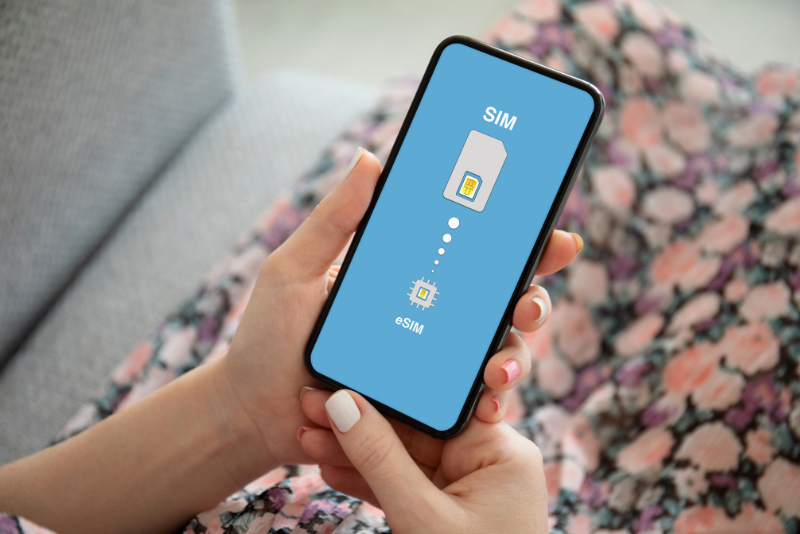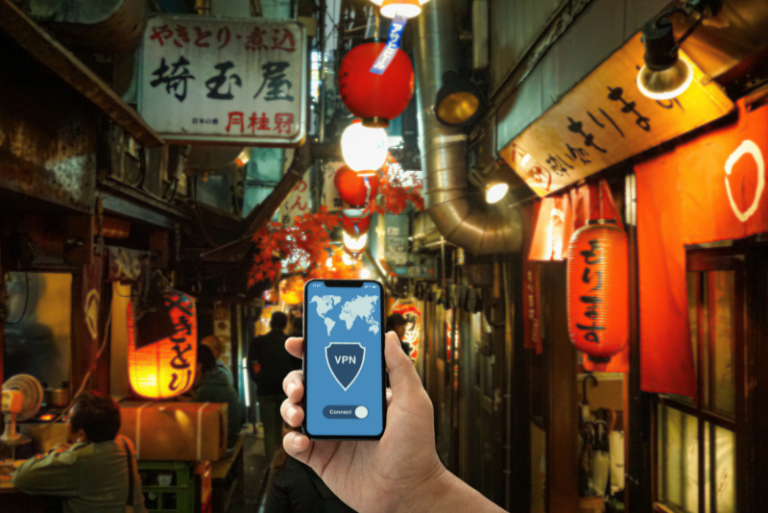I bloody hate SIM cards!
My sausage fingers are just too fat to pick them up. Whenever I change one out, I inevitably drop it on the floor. For the next 10 minutes, I’m on my hands and knees, cursing as I try to find the damn thing.
I can’t be the only one who hates changing these things out, can I?
It’s stupid technology. Why can’t we just program our phones to work on another carrier?
Obviously, I’m not the most intelligent person in the room. Greater minds than mine have come up with a solution – eSIM cards.
They sound the same, but they are totally different! An eSIM is what all of us fat-fingered humans have been waiting for. No more switching out SIM cards for your next international trip.
Read on to find out more!

What is an eSIM?

An eSIM, or embedded SIM card, is a digital form of the traditional SIM card designed to be integrated directly into your device. Unlike physical SIM cards, an eSIM is programmable via software, allowing users to switch carriers or plans without needing a physical card swap. This small but powerful chip operates similarly to a conventional SIM but with added flexibility.
eSIM vs. a Traditional SIM Card
A Physical SIM card, or Subscriber Identity Module, has been the backbone of mobile connectivity for decades. However, it has limitations – mainly the hassle of physically swapping cards. An eSIM, on the other hand, eradicates this inconvenience by allowing users to switch plans digitally, making the process seamless and more efficient.
How an Embedded SIM Works
At the heart of the eSIM is the eUICC (embedded Universal Integrated Circuit Card) chip. This tiny yet mighty chip supports remote provisioning, meaning carriers can update profiles and plans without physical intervention. This capability simplifies user experience and opens the door to more dynamic and responsive mobile connectivity solutions.
Advantages of Using eSIM
1 – Switching Between Carriers
One of the standout benefits of using an eSIM is remote provisioning. Imagine effortlessly switching between carriers from the comfort of your home or while on the go – no more visiting stores or waiting for new SIM cards to arrive by mail. With an eSIM, you can instantly switch plans and carriers through a simple digital process, making mobile connectivity more accessible and flexible.
Support for Multiple Carriers
Another game-changing feature of eSIM technology is its ability to support multiple carrier profiles. You can store several service plans on a single device and switch between them as needed. Whether you want to separate work and personal lines or optimize your connectivity while traveling, eSIMs provide unmatched versatility and convenience.
Small and Compact
The compact nature of eSIMs makes them ideal for small devices like wearables, smartwatches, and IoT gadgets. These devices often have limited space for components, and integrating an eSIM frees up valuable real estate inside the gadget. The eSIM card, with its small size and standard specifications, is particularly beneficial in these applications. This space-saving advantage allows manufacturers to design sleeker, more efficient products without compromising functionality.
Better Security
eSIMs offer enhanced security features compared to traditional SIM cards. Since they are embedded within the device and not easily removable, the risk of SIM card theft or loss decreases. Additionally, eSIMs support advanced encryption methods, ensuring secure communication between your device and mobile network.
Simplifying International Travel
Traveling internationally often involves finding local SIM cards to avoid exorbitant roaming charges. With eSIM, you can easily add a local plan without swapping physical cards. This convenience lets you stay connected affordably and without interruptions during your travels.
Device Compatibility
List of eSIM-Compatible iPhone Models
Many modern smartphones come equipped with eSIM technology. Some popular models include:
- iPhone 11 series and newer
- Google Pixel 3 and newer
- Samsung Galaxy S20 series and newer
These devices allow you to fully utilize eSIM capabilities, providing a flexible and efficient mobile experience.
Other Devices That Support eSIM
Beyond smartphones, eSIM technology is making its way into various other devices:
- Tablets such as the iPad Pro, iPad Air, and iPad Mini
- Smartwatches like the Apple Watch and Samsung Galaxy Watch
- IoT devices, including drones, smart speakers, and connected cars
The growing list of eSIM-compatible devices indicates broader adoption and integration across diverse tech ecosystems.
Future Trends
The future of eSIM technology looks promising, with increasing adoption across industries. Tech giants continually enhance their devices with eSIM capabilities, and telecom providers are expanding their support. As eSIM technology matures, we expect more innovative applications and widespread industry acceptance, making mobile connectivity more seamless.
How to Activate an eSIM
Step-by-Step Activation for Different Devices
Activating an eSIM varies depending on your device. Here’s a quick guide to some popular models:
- iPhone: Go to Settings > Cellular > Add Cellular Plan. Scan the QR code provided by your carrier.
- Google Pixel: Navigate to Settings > Network & Internet > Mobile Network > Advanced > Carrier. Then, scan the QR code.
- Samsung Galaxy: Head to Settings > Connections > SIM card manager > Add mobile plan. Follow the prompts to scan your QR code.
These steps may vary slightly, so consult your device’s user manual or carrier’s instructions for precise guidelines.
Methods of Activation
You can activate an eSIM using various methods:
- QR Codes: Scan a QR code provided by your carrier to download the eSIM profile.
- Carrier Apps: Some carriers offer dedicated apps that streamline activation with simple on-screen instructions.
- During Device Setup: Many new devices allow you to set up your eSIM during the initial device setup, making connecting easy right out of the box.
Tips to Activate Your eSIM
To ensure a smooth activation process, keep these tips in mind:
- Ensure your device is connected to wifi.
- Have your carrier’s QR code or app ready.
- Follow the on-screen instructions carefully.
- Restart your device if prompted.
These steps will help you quickly and efficiently activate your eSIM.
Best eSIM Providers
Global Providers
- Airalo: Considered the best overall eSIM provider by multiple sources. It offers good coverage and easy installation.
- Holafly: Ranked highly for offering unlimited data plans.
- Saily: Praised for being secure and offering a wide range of plans in over 150 countries worldwide.
- Ubigi: Highlighted for solid performance and easy setup process.
Japan eSIM Providers

- Mobal: Offers a variety of plans suitable for travelers in Japan.
- World eSIM: A trusted Japanese provider with good speeds.
- Sakura Mobile: Provides eSIM plans with a Japanese phone number (070-, 080-, or 090- prefixes) attached.
- Japan Wireless: Offers eSIM services for short-term travelers in Japan.
- eSIM Japan: Trusted local brand offering data packages for all of Japan or by city
Conclusion
An eSIM is not just a technological upgrade—it’s a game-changer for mobile connectivity. Whether you’re a frequent traveler, a tech enthusiast, or a business professional, understanding and utilizing eSIM technology can significantly enhance your mobile device management.
FAQ
What is an eSIM, and how does it work?
An eSIM, or embedded SIM, is a small chip built into your mobile device and serves as a digital SIM card. It stores information about your mobile plan and allows you to connect to a cellular network without a physical SIM card.
To use an eSIM, you must first activate it with a supported carrier. This can be done through the device settings or by scanning a QR code provided by the carrier. Once activated, you can switch between different plans and carriers directly on your device without changing SIM cards.
What are the benefits of using an eSIM?
The main benefit of using an eSIM is convenience. Switching between carriers and plans is much easier and faster than inserting a card into the physical SIM card slot. Additionally, eSIMs can store multiple profiles, allowing you to have different phone numbers or data plans on one device.
What is the disadvantage of eSIM?
One potential disadvantage of eSIMs is that not all carriers and devices support it yet. This means you may not have access to eSIM technology in certain areas or with specific devices. However, as more companies adopt eSIM technology, this limitation will decrease.
Can I use a VPN with my eSIM?
Using a good VPN with your eSIM is a great way to enhance your online privacy and security. A VPN (Virtual Private Network) encrypts your internet traffic, making it harder for anyone to intercept your data.
Is pocket wifi a good alternative to eSIM when traveling?
Yes, pocket wifi can be an alternative, especially if you’re traveling and need a consistent internet connection for multiple devices. Pocket wifi devices are portable and provide a secure internet connection wherever you go.
How do I stay connected in Japan on my trip?
There are several options for staying connected while traveling in Japan:
- Rent a pocket wifi device
- Purchase an eSIM card
- Buy a physical SIM card
- Roaming
- Free wifi
Hi, welcome to Events Hakuba. I started this site about eight years ago with a friend (who’s since moved away) to help travelers get more out of their time in Hakuba. What began as an event calendar has grown into a resource for everything from logistics to local insights.
It’s a one-person operation, and while I do my best to keep things current, it’s not a full-time gig—so thanks for your patience if anything’s slightly out of date.
If you’re curious about my main work, I run The Fifth Business — helping independent hotels scale guest revenue, retention, and operations without adding complexity.







